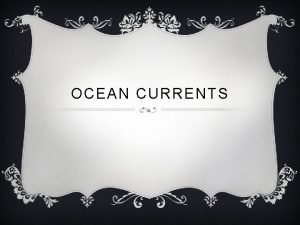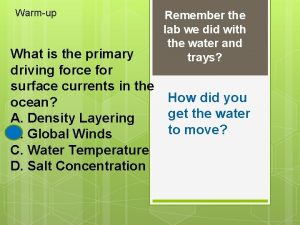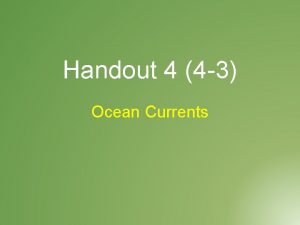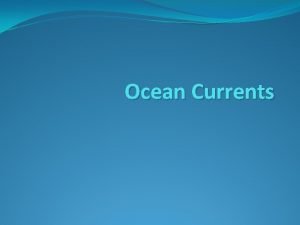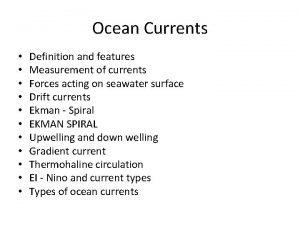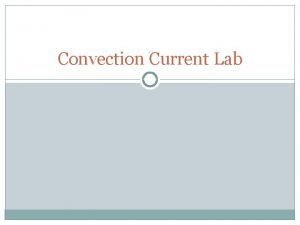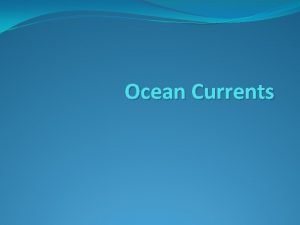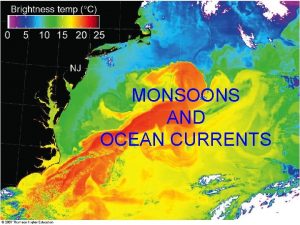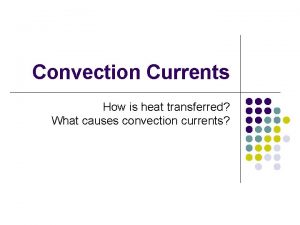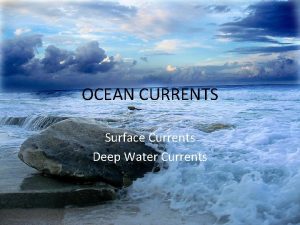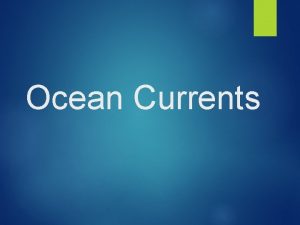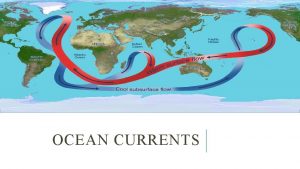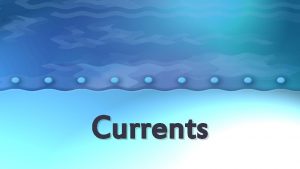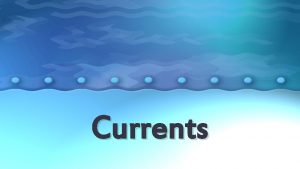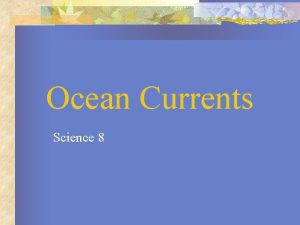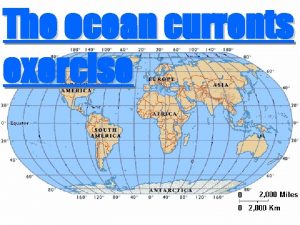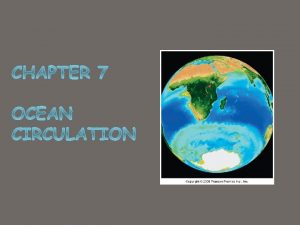OCEAN CURRENTS FACTORS THAT AFFECT SURFACE CURRENT v














- Slides: 14

OCEAN CURRENTS

FACTORS THAT AFFECT SURFACE CURRENT v A current is a horizontal movement of water in a well-defined patter, such as a river or stream. v Currents that move at or near the surface of the ocean and are driven by wind are called surface currents. Surface currents are controlled by three factors: air currents, earth’s rotation, and the location of the continents. v All surface currents are affected by the wind. Wind is caused by the uneven heating of the atmosphere. Variations in air temperature lead to variations in density and pressure.

FACTORS THAT AFFECT SURFACE WATER v Because wind is moving air, wind has kinetic energy which passes this energy to the ocean as the air moves across the ocean surface. As energy is transferred from the air to the ocean, the water at the ocean’s surface begins to move.

GLOBAL WIND BELTS v Global wind belts are major facts that affect the flow of ocean surface water. v The trade winds are located just north and south of the equator. v In the northern hemisphere the trade winds blow from the northeast. In the southern hemisphere trade winds blow from the southeast. In both hemispheres trade-wind belts push currents westward across the tropical latitudes.

GLOBAL WIND BELTS v The westerlies are located in the middle latitudes. In the Northern hemisphere, westerlies blow from the southwest. In the southern hemisphere , they blow from the northwest. Westerlies push ocean currents eastward in the higher latitudes of the Northern and Southern hemispheres.

CONTINENTAL BARRIERS AND CORIOLIS EFFECT v The continents are another major influence on surface currents. The continents act as barriers to surface currents. When a surface current flows against a continent, the current is deflected and divided. v As the earth spins on its axis, ocean currents and wind belts curve. The curving of the paths of the ocean currents and winds are known as the Coriolis effect.

CORIOLIS EFFECT v The Coriolis effect is the curving of the path of a moving object from an otherwise straight path due to the earth’s rotation. v The wind belts and the Coriolis effect cause huge circles of moving water, called gyres. v A gyre is a huge circle of moving ocean water found above and below the equator.

MAJOR SURFACE CURRENTS v Equatorial currents are located in the Atlantic, Pacific, and Indian oceans. Each of these oceans has two warm-water equatorial currents that move in a westward direction. Between these westward-flowing currents lies a weaker, east -ward flowing current called the Equatorial Countercurrent.

SOUTHERN HEMISPHERE CURRENTS v Currents move counterclockwise in the south. In the most southerly regions of the oceans, constant westward winds produce the world’s largest current, the Atlantic Circumpolar Current, also know as the West Wind Drift. v No continents interrupt this movement. v Oceans in the Indian Ocean are governed by the monsoons, whose directions change seasonally.

CURRENTS IN THE NORTH ATLANTIC v The current in the North is know as the gulf stream. This is a flow of warm water. v The Gulf Stream is the swift, deep, and warm Atlantic current that flows along the eastern coast of the United States toward the northeast.

DEEP CURRENTS v A deep current is the stream like movement of water far below the surface. v These currents form as cold, deep, water at the polar regions sinks and flows beneath the warmer ocean water. v The movement of polar water is a result of differences in density. When water cools, it contracts and the water molecules move closer together. This contraction makes the water denser, and the water sinks.

ANTARCTIC BOTTOM WATER v The temperature near Antarctica is very cold. The waters salinity is high. These two factors make the water the densest in the ocean. v This dense, cold water sinks to the ocean bottom and forms a deep current called the Antarctic bottom water. The Antarctic Bottom Water moves slowly northward along the ocean bottom. It takes hundreds of years for the current to make that trip.

NORTH ATLANTIC DEEP WATER v South of Greenland the water is very cold and has a high salinity. This cold, salty, water forms a deep current that moves southward under the northward flowing Gulf Stream. Near the equator. This deep current dives. One part begins to rise, reverse direction, and flow northward again. The rest of the current continues southward towards Antarctica and flows over the colder, denser Antarctic Bottom Water.

TURBIDITY CURRENTS v A turbidity current is a strong current caused by an underwater landslide. Turbidity currents occur when a large masses of sediment that have accumulated along a continental shelf or continental slope suddenly break loose and slide downhill. The landslide mixes the nearby water with sediment. The sediment causes the water to become cloudy, or turbid, and the denser then the surrounding water. The dense water or the turbidity current moves beneath the less dense, clear water.
 Factors that affect surface currents
Factors that affect surface currents What is a deep current
What is a deep current What is the primary driving force behind surface currents?
What is the primary driving force behind surface currents? Surface ocean currents
Surface ocean currents Citlalli dominguez
Citlalli dominguez Ocean currents vocabulary
Ocean currents vocabulary Ocean currents definition
Ocean currents definition Convection currents in the ocean
Convection currents in the ocean What causes wind to blow brainpop
What causes wind to blow brainpop Ocean currents
Ocean currents Ocean currents vocabulary
Ocean currents vocabulary Ocean currents
Ocean currents Ocean currents project
Ocean currents project What causes convection
What causes convection Rubber ducks ocean currents activity
Rubber ducks ocean currents activity
